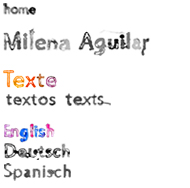The female Van Gogh
- that’s how Milena Aguilar is called in one of her little stories which she has thought out herself. The story is told from the view of a farmer. “You don’t see any traces from her, she takes every thing back with her“, the farmer says from her, the paintress. He respects her, knows that it is hard work to paint (a picture). And then, she doesn’t paint just something, she paints his fields. And that’s why the farmer waits to harvest his field and even calls it her field.
And whose field would he see if he saw the finished painting- “Rape and Barley“ it is called. His,hers? He would see them in warm, soft brown tones, separated by a luminous green way which leads to a small hunters’ hut. He would see a row of trees in the upper half of the picture and would recognize each tree, so exactly it is painted. And he would also recognize the fringe of the wood behind and the piece of pigeon grey sky, that every-day-sky which is nothing less than the sum of all our summerskies (and how hot it can be under such skies. And how hot it was when this painting was made...). We won’t demand too much of the farmer, but if he began to take interest in Milena Aguilar’s paintings he would meet this sky many a time together with, soft fields and the row of trees which sometimes would be a row of houses. And little by little his field would become something else, not his, not hers, part of an art rather whose sense is time. The time that passes and melts before our eyes even if time is said to circulate.
If you let the picture grow into you, you begin to hear the humming of a fly coming nearer, leaving and coming back again. Perhaps this humming comes indeed from one of those dead flies which Milena Aguilar has fixed in filigreen etchings to catch in duration?
But stop, no more tittle-tattle: back to here and now. Back to work. To the tractor, to the field, to “the world‘s biggest studio“, as she says. After having found a place promising something (not last peace and quiet) and having taken out easel, paints and other equipment she begins something which the author of these lines can only vaguely describe and which starts with the selection of the size of the picture. There are several sizes to choose. The square ones are difficult for landscapes, the biggest one’s length is 114,5cm, “Rape and Barley “ measures 30x44 cm. Later on the objects are grouped on the canvas and then the blots put on them. The shadows and not last the colours look plastic and you can see clearly their materiality. In that, Milena Aguilars’s pictures which you can confuse with photographs ( but only because we are so used to photographs) are different from hyperrealism. Of course she also has her camera with her to be able to finish a painting at home just in case the weather or some lowersaxon farmer or a metalscrap owner don’t agree with her. But really only in these cases. Already she finds it difficult to leave out a thing in a section not to say to add it. And if a lake is called “Restloch“(remnent hole) or a locality “Galgenstrich“(gallows line) it’s because they are their names. She has a great respect for what is there and how it is there. Should one rather call it respect for the creation?
But let’s put that apart- she doesn’t like anything pathetic. And still there is in her pictures which don’t look so exciting a tranquil longing and expectance.
The contemplator felt it in the painting “Dammwildgehege“ which is penetrated by a lumininous calm. This solemn trait he’ll find again in the Meadow and the Rapefield. And there is also an incertain longing in a gem like the Mountain Deister a remembrance of older panorama pictures of the surronding of Helmstedt where the eyes get lost like in those landscapes in the north of Italy by the film director Michelangelo Antonioni- the expression Antonioni pictures is declared now an expression of technique.
In some pictures finally the longing has retracted completely to a few high buildings at the surrounding of the town or in to the dark anorak of a child who is standing in a snow landscape: Winter is the longest (picture). This is right in every respect.
Michael Angele, 2005

